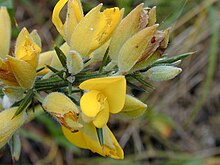European gorse
| Common gorse | |
|---|---|
 |
|
| Common Gorse flowers | |
| Scientific classification | |
| Kingdom: | Plantae |
| (unranked): | Angiosperms |
| (unranked): | Eudicots |
| (unranked): | Rosids |
| Order: | Fabales |
| Family: | Fabaceae |
| Subfamily: | Faboideae |
| Genus: | Ulex |
| Species: | U. europaeus |
| Binomial name | |
|
Ulex europaeus L. |
|
Ulex europaeus (gorse, common gorse, furze or whin) is a species of flowering plant in the family Fabaceae, native to portions of Europe from the northern United Kingdom south to Portugal, and from the western Republic of Ireland east to Galicja in Poland and Ukraine.
Growing to 2–3 metres (7–10 ft) tall, it is an evergreen shrub. The young stems are green, with the shoots and leaves modified into green spines, 1–3 centimetres (0.39–1.18 in) long. Young seedlings produce normal leaves for the first few months; these are trifoliate, resembling a small clover leaf.
The flowers are yellow, 1–2 centimetres (0.39–0.79 in) long, with the pea-flower structure typical of the Fabaceae; they are produced throughout the year, but mainly in early spring. The fruit is a legume (pod) 2 centimetres (0.79 in) long, dark purplish-brown, partly enclosed by the pale brown remnants of the flower; the pod contains 2-3 small blackish, shiny, hard seeds, which are ejected when the pod splits open in hot weather. Seeds remain viable for 30 years.
Like many species of gorse, it is often a fire-climax plant, which readily catches fire but re-grows from the roots after the fire; the seeds are also adapted to germinate after slight scorching by fire. It has a tap root, lateral and adventious roots. An extremely tough and hardy plant, it can live for about thirty years.
The species has been introduced to other areas of Europe, and also to the Americas, New Zealand, South Africa, and Australia, where it is often considered a weed and is a serious problem invasive species in some areas (notably the western United States, Chile and New Zealand). It was introduced to New Zealand from Scotland as a type of hedge, but became a major blight to farmers as the climate suited its growth better than its native habitat and many of its natural predators were absent.
...
Wikipedia
